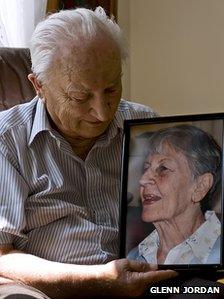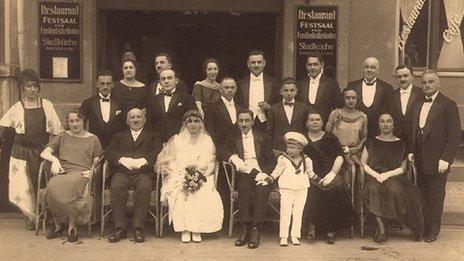Cardiff Reform Jewish memories in Hineni exhibition
- Published

Family firm: young Wally Salamon, founder of Wally's Delicatessen in Cardiff, sits with his brothers and mother outside his father's shop in Austria circa 1938
Jewish people from south Wales have shared their memories and experiences for an exhibition in Cardiff.
More than 60 members of the Reform Jewish community were interviewed over three years for the Hineni project.
Project manager Colin Heyman said it showed how Reform Jews had adapted to life in Wales in different ways.
"People had such different experiences to share," he said. "By knowing more about our past we can also move more confidently into our future."
Memories featured in the exhibition range from people who fled central Europe in the 1930s to their children subsequently born in Wales, and Reform Jews whose families had settled in the UK at other times.

Desidier Golten left Slovakia as an infact and met his wife Ina in an orchestra in Pontypridd
The Reform community, which follows a more liberal version of Judaism than the Orthodox community, grew in Wales in the 1930s as the number of Jews fleeing the Nazis increased.
The only progressive - as opposed to traditional - Jewish community in Wales, it numbers around 250.
Cardiff Reform Synagogue was awarded over £33,000 from Heritage Lottery Fund (HLF) in 2010 to provide project volunteers with specialised training in oral history, archiving, interviewing and the digital technology skills needed to document the stories.
Project manager Colin Heyman said: "We wanted to capture the fascinating stories and memories from community members, which is how the project came about.
"As the project progressed, we realised that people had such different experiences to share, from Welsh speaking Jews to taxi drivers, and so the exhibition needed to truly reflect the diversity of our community.
"Visitors will also gain an understanding of how the Reform Jewish community and Welsh people have interacted over the last 60 years or so.
"By knowing more about our past we can also move more confidently into our future."
Diana Soffa, one of the volunteers involved, said a previous attempt to gather memories 10 years ago proved too painful for some.
She told BBC Wales: "It was very emotional, which was the reason we didn't go ahead 10 years ago. Now it's so far back they can handle it.
"Most of the older people we have left (central Europe) as children. The others are no longer with us. The last time they saw their family, they were standing on a station platform. They were too young to know what was going on.
"None of them as youngsters spoke English when they came over here. Some were lucky to have family that followed them. They've lived with for so long now.
"I was gratified with how open people were with their life stories. The big thing that came across was how important the community was for them. It's very supportive in time of trouble.
"The big surprise was how much we didn't know about each other, mostly interests that we shared such as books and music and theatre."

The wedding of Rudi Montrose's parents in Berlin in 1923
The Reform community worked in partnership with Butetown History and Arts Centre (BHAC), experienced in portraying minority communities in Cardiff.
BHAC director Glenn Jordan said, "I am very pleased to be involved with this project as a photographer and oral historian.
"These are stories that need to be told; these are faces that deserve to be remembered."
The Hineni exhibition will be on show at the Cardiff Story museum until 28 September and then travels to museums across the UK.
On Tuesday, 18 September at the museum, Dr Glenn Jordan of Butetown History and Arts Centre and Colin Heyman of Cardiff Reform Synagogue will explain how the exhibition was put together.
- Published29 September 2011